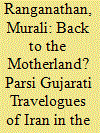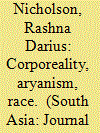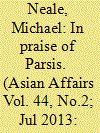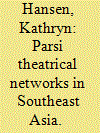|
|
|
Sort Order |
|
|
|
Items / Page
|
|
|
|
|
|
|
| Srl | Item |
| 1 |
ID:
189067


|
|
|
|
|
| Summary/Abstract |
The publication of four Gujarati travelogues written by Parsis traveling to Iran in quick succession in the 1920s marked the intensification of a relationship that had hitherto been based mainly on philanthropy directed towards the Zoroastrians of Iran. The Pahlavi regime, with its assurances of religious tolerance and equity, prompted Parsis to consider deepening their connection with Iran through trade and business investments and also examine the possibility of return to their motherland. The encounters which constitute these travelogues could be framed as experiments which helped the Parsi community in India to construct a framework for developing this relationship. The Parsi travelogues, while attempting to recover a Zoroastrian past in Iran, also try to map the future for the community by addressing its present anxieties and aspirations.
|
|
|
|
|
|
|
|
|
|
|
|
|
|
|
|
| 2 |
ID:
142833


|
|
|
|
|
| Summary/Abstract |
Recent scholarship has problematised the ‘impact-response’ theory that ideas such as Aryanism, eugenics and militarism were merely imported from a European context into a South Asian one. This paper delineates a longer trajectory of the relationship between corporeal language and communal identity through a focus on the Parsi community of western India. As early as 1853, reformist Parsis enacted modes of ancient Kayānī virility in the gymnasium and theatre to redefine notions of communal identity that drew simultaneously from Enlightenment precepts and a mythic Aryan heritage discovered by Orientalists. Subsequently, the confluence of a loss of numerical, financial and political strength, and the popularisation of the ideas of Darwin and Mendel, prompted a shift in ethnic and semantic thinking, whereby the language of corporeality was co-opted by the orthodox faction to justify the bifurcation of religion and race. Consequently, Parsis, in the midst of a rising Hindu nationalist movement, called not only for the revival of Persian epic theatre, a Parsi militia, the exclusion of ‘half-castes’ from the community and the castration of ‘mentally defective’ community members, but also for a renewal of ties to Iran and a separate state of Parsistan.
|
|
|
|
|
|
|
|
|
|
|
|
|
|
|
|
| 3 |
ID:
120999


|
|
|
|
|
| Publication |
2013.
|
| Summary/Abstract |
There has been a catastrophic decline in the numbers of India's vultures, on which the Parsis once depended for the disposal of their dead. Parsi numbers are falling too. Their community represents only 0.0005 per cent of the population of the Indian subcontinent, yet they have made such a mark in so many walks of life. Could Zoroastrian culture explain their disproportionate success? Parsi shipbuilders built frigates of Malabar teak for the British Navy and the EIC, Parsis provided the brains behind India's nuclear programme, the backbone of India's manufacturing industry and such international musical icons as Zubin Mehta and Freddie Mercury, as well as the first Asian MPs at Westminster and the first Indian cricket team to tour England,. Parsi merchant-princes made fortunes in the opium trade yet rivalled Andrew Carnegie in their philanthropy.
|
|
|
|
|
|
|
|
|
|
|
|
|
|
|
|
| 4 |
ID:
157733


|
|
|
|
|
| Summary/Abstract |
Rangoon circa 1900 was known as ‘one of the best show towns in the East’. As the capital city of Burma, then ruled from Calcutta as a province of India, it was home to more Indian nationals than Burmese. In this cosmopolitan context, two vernacular arts complexes — the Parsi theatre of India and the popular zat-pwe of Burma — flourished, competed, and converged. This article documents the 55-year long engagement of Parsi theatre in Burma within the larger history of global theatrical flows in the Indian Ocean. It highlights the story of Dosabhai Hathiram, a theatre man who rooted himself in Rangoon his entire life. And it asks, why was Parsi theatre celebrated elsewhere in Southeast Asia as a vector of modernity, and yet in Burma it left scarcely a trace behind?
|
|
|
|
|
|
|
|
|
|
|
|
|
|
|
|
|
|
|
|
|